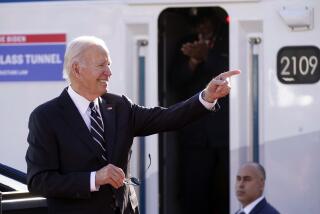New toll ‘Greenway’ to ease D.C. commute : The profitable, environmentally sensitive route through Virginia is due to open in 1996.
- Share via
LEESBURG, Va. — It used to require a special occasion for folks in Leesburg to travel to Washington.
And only on weekends and summer sojourns did residents of the nation’s capital come out to this picturesque old town in the foothills of the Blue Ridge. It was not intended to be a suburb. It was not created with the automobile in mind.
But now, like communities from the mountains to the Chesapeake Bay, Leesburg has become a place where Washington’s political people, business workers and federal civil servants retreat for a short night’s sleep between workdays.
During the winter months, the morning rush into the center of the urban sprawl begins before dawn. Bridges crossing the Potomac River into Washington are more than an hour and as many as 23 traffic lights away. Congestion thickens with each passing month, and the lines of pull-up-and-stop traffic stretch for miles behind wrecks and bottlenecks.
But the harassed commuters of Leesburg and points west have the word of retired Army Corps of Engineers Maj. Gen. Charles E. Williams that come March, 1996, the trip from here to Washington will be reduced to about 32 minutes. And that, he says, should be good news all across America.
Private investors have set out to build a 14-mile, $326-million road from Dulles International Airport to Leesburg, figuring eventually to turn handsome profits from motorists who will be charged $1.75 for the quick trip through the rolling Virginia countryside.
Williams is the ramrod for the undertaking, which he offers as a model for all states now seeing their highway budgets consumed by the upkeep of aging bridges and deteriorating roadways.
“I hope the country is watching what is happening here,” he said as an army of road-building machines marched across a Loudon County dairy farm last week. “With 45% of the dollar going to maintenance, the state of Virginia does not have enough money to build new infrastructure. This represents a new business, a new way of doing infrastructure projects.”
Participants in Toll Road Investors Partnership II and their bankers pin their high expectations on Williams’ ability to cut red tape and bring extraordinary efficiency to the construction.
So far, he has not disappointed.
Work, begun Sept. 29, is ahead of schedule. Right-of-way clearing has been completed. Sixteen bridges are under construction. Brown & Root Construction Co., working under a $145-million contract, has 114 pieces of heavy equipment deployed along the route. Work goes forward six days a week in two 10-hour shifts.
Unexpected snags that might otherwise take weeks are resolved in hours, project participants say. How? By having designers, bankers, insurers and state officials on site with the contractors and the owners’ management team, headed by Williams.
On the environmental front, project officials took the offensive early. They are attempting to mitigate their destruction of 64 acres of wetlands by reclaiming a nearby 125-acre wetland site that had been destroyed by farming operations years ago. Along a stretch where a sound barrier is needed, they plan to create tree-covered dirt berms rather than erect metal or masonry walls. They are not even calling their road a road. Officially, it is the Dulles Greenway.
Williams promises that the new link will not only shorten the trip from Leesburg into the Washington area, but will also make it pleasant. The roadway will be tree-lined, and its interchanges will be surrounded by flowers.
Acknowledging that growth will overtake the new road as it has all the others, designers provided a right of way broad enough for two additional lanes in the future, with enough space left to add a railway.
Although a limited partnership in Orange County has built privately owned toll lanes along 10 miles of the Riverside Freeway, Williams says the United States has seen nothing like the Virginia project in a century.
“If you are talking about creating a right of way and building a new, privately owned road from scratch, this is the first time that has happened in your country and mine in more than 100 years,” he said.
Federal highway officials say they cannot confirm this, but they see clear signs of a comeback for privately owned toll roads.
*
Pressures to find new means of financing roads have mounted steadily since the 1980s. Several states have adopted legislation explicitly permitting private highway projects. The 1991 Intermodal Surface Transportation Efficiency Act allows the allocation of federal funds to such efforts.
Williams says his office receives “oodles of calls” from potential investors and others interested in imitating the Dulles Greenway.
“Everybody will win in these things,” he said, “the state, the public, developers, investors. It’s an idea that’s not going to die. Its time has come.”
More to Read
Sign up for Essential California
The most important California stories and recommendations in your inbox every morning.
You may occasionally receive promotional content from the Los Angeles Times.












